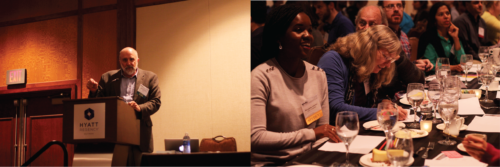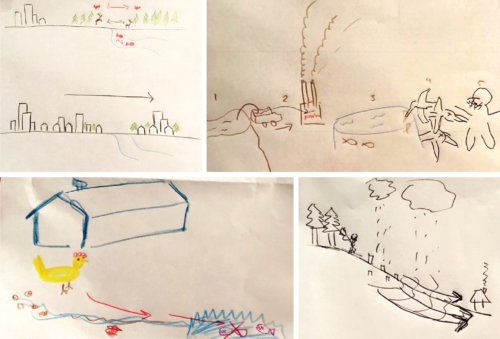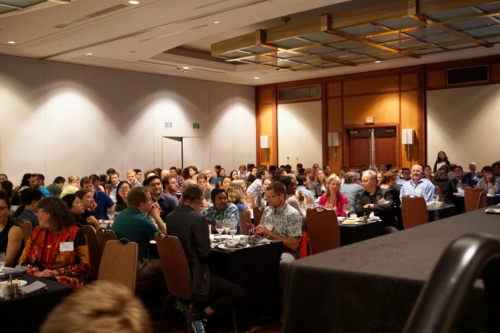Tell a compelling story: Talking about science communication to landscape ecologists in Baltimore
Bill Dennison ·The 2017 annual meeting of the US chapter of the International Association of Landscape Ecologists was held in Baltimore at the Hyatt Regency Hotel in the Inner Harbor. Andrew Elmore, my University of Maryland Center for Environmental Science colleague, invited me to present the banquet keynote. Since any after dinner talk should not be all too serious, Andrew and I opted to develop an interactive session. I recruited Dylan Taillie and Jamie Currie to help out and we staged a round of Conceptionary with 240 people. Conceptionary is a game that our Integration and Application Network has developed in which groups of 4-6 people take turns having one person draw a conceptual diagram using colored pencils. The team members then guess the concept being depicted. We passed out five different Conceptionary cards so we ended up with an array of different diagrams. The drawings were then collected and displayed on four giant projection screens so everyone could view them. The audience voted for the best diagram by the amount of applause registered by my "applause-o-meter" arm raising. The person who drew the best diagram for each Conceptionary topic was awarded an IAN multicolor marker. This was the largest crowd of simultaneous Conceptionary we have ever attempted. I was nervous that it would be a logistical nightmare to pull off, but it went amazingly well. There was a lot of laughter at some of the drawings, particularly when I zoomed in on a specific symbol.

We initiated another activity to focus on developing better narratives for use in science communication. This activity was based on Randy Olson's book "Houston, We Have a Narrative". We passed out 'fill in the blank' cards with two sides. One side was the one word template "Nothing in _________ makes sense, except in light of __________ ." The most common statement was the following: "Nothing in landscape ecology makes sense, except in light of scale." I suppose this should not be surprising considering the audience. A range of different words were selected to describe ecology: "Nothing in ecology makes sense, except in light of contingency / complex systems / evolution / hierarchy / context" A couple other examples were the following: "Nothing in agriculture makes sense, except in light of soil", "Nothing in urban ecology makes sense, except in light of human interactions", "Nothing in demography makes sense, except in light of dispersal", "Nothing in conservation makes sense, except in light of people".
The other side of the 'fill in the blank' card was the ABT template (" . . . and . . . but . . . therefore . . ."), which is also the central theme in Randy Olson's book. The ABT statements that were generated were very creative. Some examples are the following:

- "Vacant lots make up a huge area and are highly connected in cities, but they are associated with blight and social divestment, therefore we had to take a socio-ecological approach to utilizing/maximizing these spaces."
- "Climate change is happening, and species are threatened, but we have limited funds, therefore we must prioritize key areas."
- "The gopher tortoise is a keystone species, and ecosystem engineer, but it is threatened by land use change, therefore a conservation strategy for tortoises will benefit many other species that inhabit long leaf pine forests."
- "Cities are home to over 50% of people, and provide considerable ecosystem services, but are often ignored in research, therefore we need to pay more attention to urban nature."
- "Fish taxa are limited by low summer flows, and peak temperatures, but barriers prevent fish from reaching optimal habitat, therefore we need models that incorporate both connections and barriers."
- "Monarch butterflies migrate through Texas to Mexico, and it is thought that roadkill may be important, but no one has studied it in Texas, therefore we surveyed and modeled monarch roadkill in Texas."
- "The Rio Grande River is the 5th largest river system in North America, and it is the water source for 10.5 million people, but it is governed by multiple levels of authority, therefore we are developing an agent based model to understand how social processes affect water resources to better inform stakeholders for a more water resilient future."
- I enjoyed the 'tongue in cheek' responses as well, and a couple of examples are the following; "Nothing in life makes sense, except in light of wine" and "I am not creative and don't want to do this, but I'm a team player, therefore I am writing on this card."

This annual meeting has a wonderful tradition of catalyzing conversations between senior scientists and graduate students. The senior scientists can purchase drink tickets in advance for random distribution to graduate students. The name of the senior scientist is on the drink ticket and to redeem the tickets, the students are required to approach the senior scientist sponsor to thank them. This serves to break the ice and often leads to a conversation about the student's research. For example, I had a wonderful conversation with Tristan Nunez about his research on hippopotamus feeding which had remarkable similarities to dugong feeding, something our Marine Botany group at the University of Queensland studied. I love this concept and will recommend that we do this at other conferences.

The conference organizers did a great job, and it was nice to see leadership emerging from local scientists like Matt Baker (University of Maryland Baltimore County), Andrew Elmore (University of Maryland Center for Environmental Science) and Todd Lookingbill (University of Richmond). I enjoyed the plenaries by Ann Swanson (Chesapeake Bay Commission), Hugh Possingham (University of Queensland) and J. Morgan Grove (U.S. Forest Service)/Steward Pickett (Cary Institute). Morgan shared a couple of papers with me that correlated increasing urban tree canopies with crime reduction in Baltimore. Hugh Possingham is a former University of Queensland colleague who is now the Chief Scientist for the Nature Conservancy. Ann Swanson is one of the leaders in the Chesapeake restoration effort.

All in all, I was happy to have the opportunity to be involved with this vibrant scientific society of landscape ecologists. They are tackling important problems with scientific rigor and they have an awareness of the broader societal issues linked with those problems. I hope that the contribution that Dylan Taillie, Jamie Currie and I could make will resonate with these landscape ecologists as they continue to tackle important environmental issues and improve their communication skills.
About the author
Bill Dennison

Dr. Bill Dennison is a Professor of Marine Science and Vice President for Science Application at the University of Maryland Center for Environmental Science.

